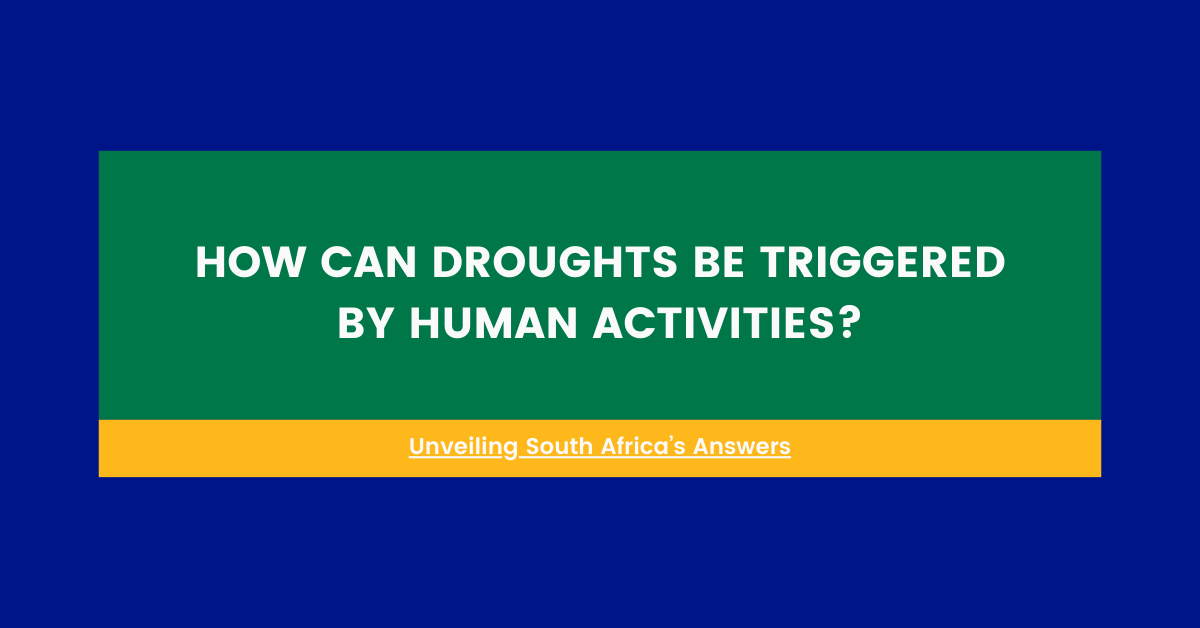In the vast and diverse landscape of South Africa, droughts have become an increasingly prevalent concern, impacting various sectors and communities. While natural climatic patterns play a significant role in the occurrence of droughts, human activities have also emerged as a contributing factor, exacerbating the severity and frequency of these events. Understanding the intricate relationship between human actions and drought formation is crucial for mitigating the devastating effects of these phenomena.
Anthropogenic Climate Change
One of the most significant human-induced drivers of droughts in South Africa is anthropogenic climate change. The burning of fossil fuels, deforestation, and other human activities have led to an increase in greenhouse gas emissions, trapping more heat in the Earth’s atmosphere. This phenomenon, known as the greenhouse effect, has caused global temperatures to rise, disrupting weather patterns and precipitation cycles.
As temperatures rise, the rate of evaporation from water bodies and soil increases, leading to drier conditions. Additionally, warmer air can hold more moisture, potentially reducing rainfall in certain regions. These factors contribute to the development and intensification of droughts, particularly in areas already prone to water scarcity.
Unsustainable Water Management Practices
Inefficient and unsustainable water management practices can also trigger or exacerbate droughts in South Africa. Excessive extraction of groundwater for agricultural, industrial, and domestic purposes can deplete aquifers faster than they can be replenished naturally. This overexploitation of groundwater resources can lead to a reduction in water table levels, making the region more susceptible to drought conditions.
Furthermore, inadequate water infrastructure and inefficient irrigation systems can result in significant water losses through evaporation and leakage. These losses not only strain water resources but also contribute to the depletion of soil moisture, increasing the risk of drought conditions.
Land-Use Changes and Deforestation
Deforestation and other land-use changes can also play a role in triggering droughts in South Africa. Forests act as natural sponges, absorbing and retaining moisture from the soil and atmosphere. However, when forests are cleared for agricultural or urban development purposes, this natural water absorption capacity is diminished.
The removal of vegetation can increase surface runoff, reducing the amount of water that infiltrates the soil and replenishes groundwater reserves. Additionally, deforestation can lead to soil erosion and degradation, further exacerbating drought conditions by reducing the soil’s ability to retain moisture.
Overgrazing and Soil Degradation
Overgrazing, a common practice in parts of South Africa, can contribute to soil degradation and increase the risk of droughts. When livestock populations exceed the carrying capacity of the land, they can lead to the removal of vegetation cover, compaction of soil, and erosion.
Degraded soils have a reduced ability to absorb and retain moisture, making the land more susceptible to drought conditions. Furthermore, the loss of vegetation cover can increase surface runoff and evaporation rates, further exacerbating the effects of drought.
Urbanization and Impermeable Surfaces
Rapid urbanization and the associated increase in impermeable surfaces, such as concrete and asphalt, can also contribute to the formation of droughts in South Africa. These surfaces prevent water from infiltrating the soil, leading to increased surface runoff and reduced groundwater recharge.
As urban areas expand, the demand for water resources also increases, putting additional strain on already limited water supplies. This can exacerbate drought conditions, particularly in regions where water resources are already scarce.
Mitigating Drought Through Sustainable Practices
To address the human-induced factors contributing to droughts in South Africa, a multi-faceted approach involving sustainable practices is essential:
- Climate Change Mitigation: Reducing greenhouse gas emissions through the adoption of renewable energy sources, improved energy efficiency, and sustainable land-use practices can help mitigate the effects of anthropogenic climate change and its subsequent impact on drought formation.
- Water Conservation and Management: Implementing water-efficient irrigation techniques, promoting water reuse and recycling, and investing in water infrastructure can help reduce water waste and ensure sustainable water resource management.
- Afforestation and Reforestation: Promoting afforestation and reforestation efforts can help restore natural water absorption capacities, reduce soil erosion, and improve overall ecosystem resilience to drought.
- Sustainable Land Management: Adopting sustainable agricultural practices, such as rotational grazing, conservation tillage, and agroforestry, can help maintain soil health, reduce erosion, and improve water retention capacity.
- Urban Planning and Development: Incorporating green infrastructure, permeable surfaces, and sustainable urban drainage systems in urban planning can help reduce surface runoff and promote groundwater recharge, mitigating the impact of urbanization on drought formation.
- Public Awareness and Education: Raising public awareness about the importance of water conservation, sustainable practices, and the impact of human activities on drought formation can empower individuals and communities to take proactive measures and adopt more sustainable lifestyles.
In the face of increasing drought risks in South Africa, addressing the human-induced factors contributing to these events is crucial for ensuring water security, safeguarding livelihoods, and promoting environmental sustainability. By adopting a holistic approach that combines mitigation strategies, sustainable practices, and public engagement, South Africa can work towards building resilience against droughts and preserving its natural resources for future generations.
